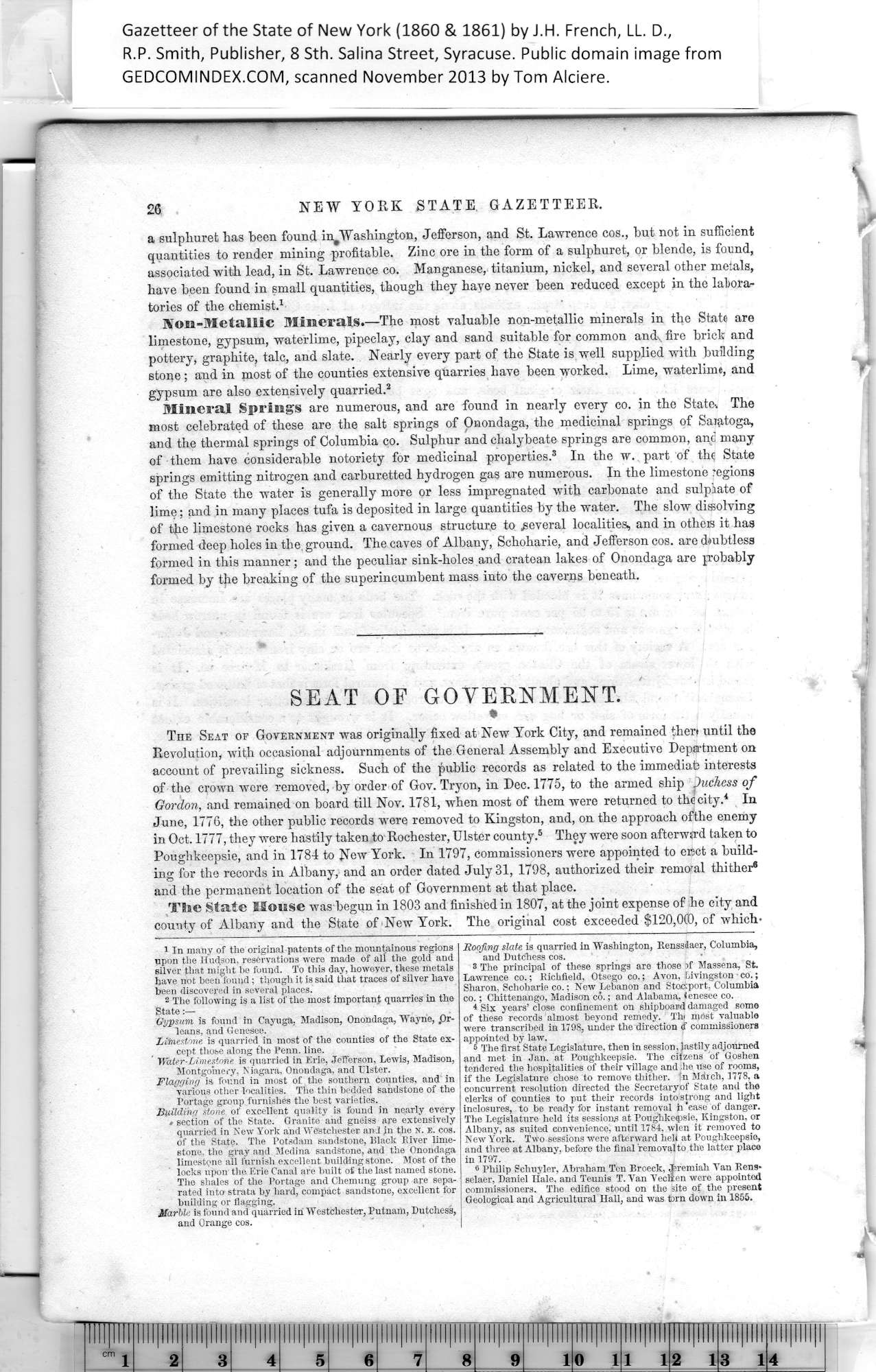|
NEW YORK STATE GAZETTEER.
a sulpliuret has been found in#Washington, Jefferson, and St. Lawrence cos., but not in sufficient
quantities to render mining profitable. Zinc ore in the form of a sulphuret, or blende, is found,
associated with lead, in St. Lawrence co. Manganese, titanium, nickel, and several other metals,
have been found in small quantities, though they have never been reduced except in the labora¬
tories of the chemist.1
Non-Metalllc Minerals.—The most valuable non-metallic minerals in the State are
limestone, gypsum, waterlime, pipeclay, clay and sand suitable for common and,, fire brick and
pottery, graphite, talc, and slate. Nearly every part of the State is well supplied with building
stone; and in most of the counties extensive quarries have been worked. Lime, waterlime, and
gypsum are also extensively quarried.2
Mineral Springs are numerous, and are found in nearly every co. in the State-. The
most celebrated of these are the salt springs of Onondaga, the medicinal springs of Saratoga,
and the thermal springs of Columbia co. Sulphur and chalybeate springs are common, anc many
of them have considerable notoriety for medicinal properties.3 In the w. part of the State
springs emitting nitrogen and carburetted hydrogen gas are numerous. In the limestone legions
of the State the water is generally more or less impregnated with carbonate and sulpiate of
lime; and in many places tufa is deposited in large quantities by the water. The slow dissolving
of the limestone rocks has given a cavernous structure to .several localities, and in others it has
formed deep holes in the ground. The caves of Albany, Schoharie, and Jefferson cos. are doubtless
formed in this manner; and the peculiar sink-holes and eratean lakes of Onondaga are probably
formed by the breaking of the superincumbent mass into the caverns beneath.
SEAT OF GOVEBNMENT.
The Seat of Government was originally fixed at New York City, and remained thert until tho
Revolution, with occasional adjournments of the General Assembly and Executive Department on
account of prevailing sickness. Such of the public records as related to the immediate interests
of the crown were removed, by order of Gov. Tryon, in Dec. 1775, to the armed ship Duchess of
Gordon, and remained on board till Nov. 1781, when most of them were returned to the city.'1 In
June, 1776, the other public records were removed to Kingston, and, on the approach ofthe enemy
in Oct. 1777, they were hastily taken to Rochester, Ulster county.3 They were soon afterwrrd taken to
Poughkeepsie, and in 1784 to New York. In 1797, commissioners were appointed to ersct a build¬
ing for the records in Albany, and an order dated July 31, 1798, authorized their removal thither4
and the permanent location of the seat of Government at that place.
Tlie State Mouse was begun in 1803 and finished in 1807, at the joint expense of he city and
county of Albany and the State of New York. The original cost exceeded $120,0C0, of which*
|
Roofing slate is quarried in Washington, Kenssdaer, Columbia,
and Dutchess cos.
® The principal of these springs are those )f Massena, St.
Lawrence co.; Richfield, Otsego co.; Avon, hivingston co.;
Sharon, Schoharie co.; New Lebanon and Stoc:port, Columbia
co.; Chittenango, Madison co.; and Alabama, (enesee co.
* Six years’ close confinement on shipboard damaged some
of these records almost beyond remedy. Tin most valuable
were transcribed in 1798, under the direction cf commissioners
appointed by law.
5 The first State Legislature, then in session, lastily adjourned
and met in Jan. at Poughkeepsie. The citzens of Goshen
tendered the hospitalities of their village and lie use of rooms,
if the Legislature chose to remove thither. In March, 1778, a
concurrent resolution directed the Secretary of State and the
clerks of counties to put their records into strong and light
inclosures, to be ready for instant removal n "ease of danger.
The Legislature held its sessions at Poughkeqjsie, Kingston, or
Albany, as suited convenience, until 1784, wlen it removed to
New York. Two sessions were afterward belt at Poughkeepsie,
and three at Albany, before the final removal to the latter place
in 1797.
6 Philip Schuyler, Abraham Ton Broeck, J’remiah Van Rens¬
selaer, Daniel Hale, and Teunis T. Van Vecbten were appointed
commissioners. The edifice stood on the site of the present
Geological and Agricultural Hall, and was torn down in 1855. |
1
In many of the original patents of the mountainous regions
upon the Hudson, reservations were made of all the gold and
silver that might be found. To this day, howsyer, these metals
have not been found; though it is said that traces of silver have
been discovered in several places.
2
The following is a list of the most important quarries in the
State:—
3
Flagging is found in most of the southern counties, and in
various otiier localities. The thin bedded sandstone of the
Portage group furnishes the best varieties.
Building stone, of excellent quality is found in nearly every
. section of the State. Granite and gneiss are extensively
quarried in New York and Westchester and in the N. E. cos.
of the State. The Potsdam sandstone, Black Biver lime¬
stone, the gray and Medina sandstone, and the Onondaga
limestone all furnish excellent building stone. Most of the
locks upon the Erie Canal are built of the last named stone.
Tho shales of the Portage and Chemung group are sepa¬
rated into strata by hard, compact sandstone, excellent for
building or flagging.
4
Marble is found and quarried in Westchester, Putnam, Dutchess,
and Orange cos.
|
